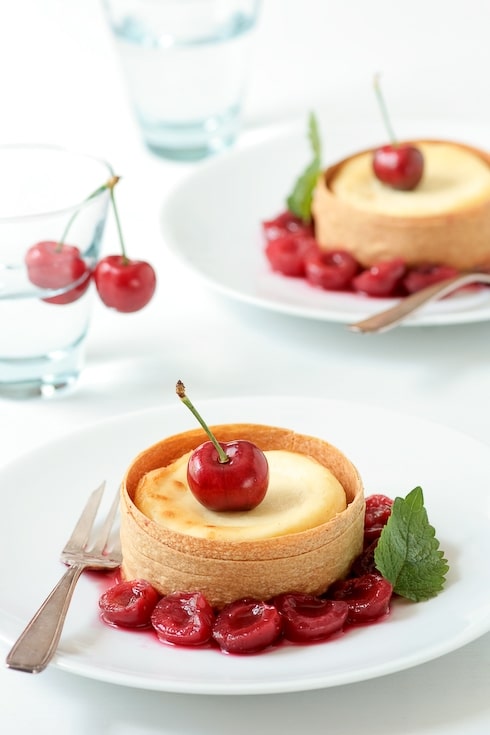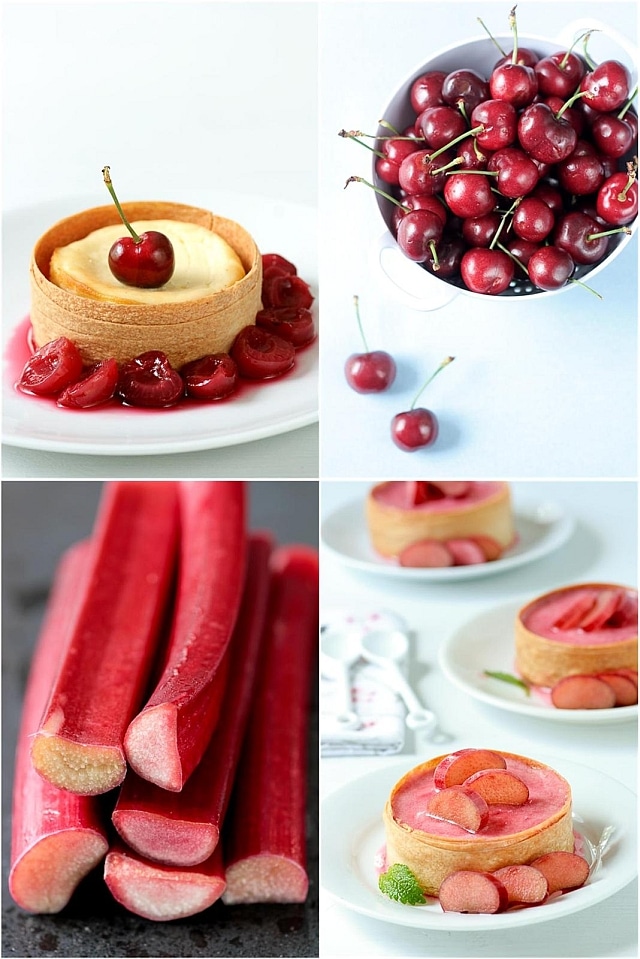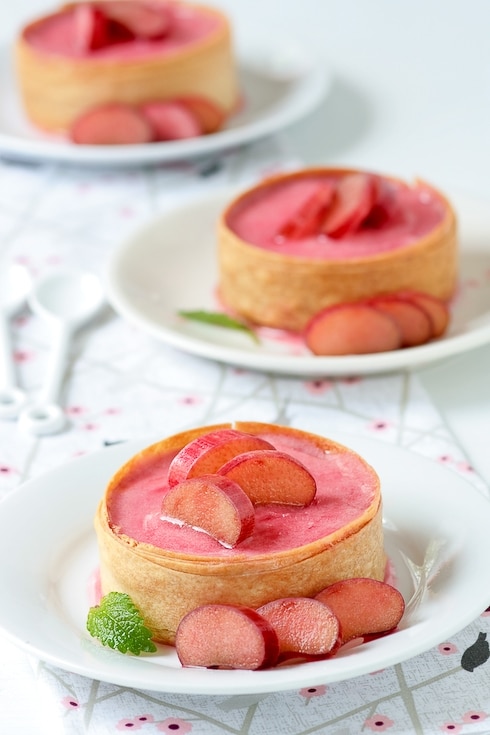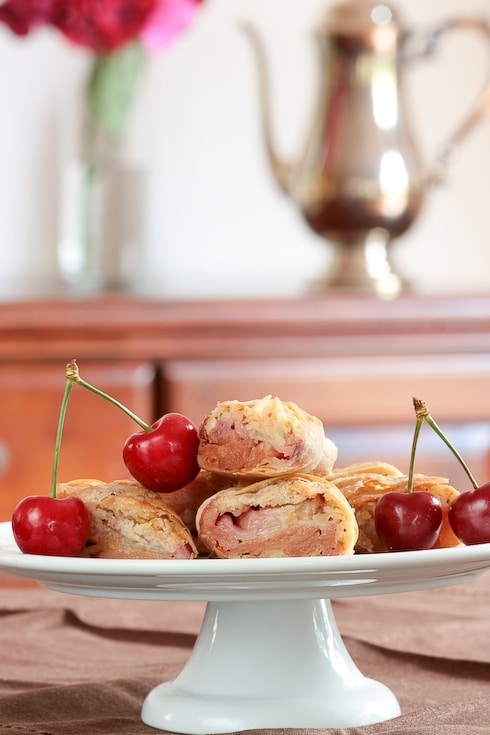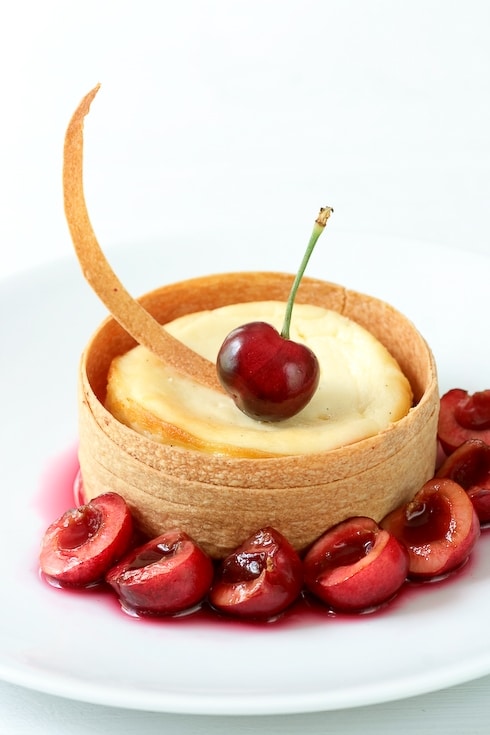It’s been a long time since I made strudel dough and it’s been even longer since I made it for our own eating pleasures. When I first moved to the US, one of my first pastry jobs was at a German bakery where we would make strudel dough by the buckets, starting fresh and early around 3am. I made so much strudels in that one year there that I overdosed a little and never made it at home after that. When I saw that the Daring Bakers challenge for May was strudel I had a split reaction. A "meh" followed by "oh wait I have always wanted to do this and this and this…"
The instructions were to make the strudel dough per the recipe given but allowed us to get creative as far as the fillings, shapes and sizes. I started with one idea and as (most) usual, I ended up with three. My first idea was not to make a traditional strudel and I blame Richard Leach for that. I have been itching to make his Ricotta Cheese Tarts in Strudel Rings since the first day I flipped the pages of his book "Sweet Seasons". I refrained from it up until now because of that studel making overdose mentionned above. Ha! No more! I had the perfect opportunity!
For the strudel rings, I rolled and stretched the dough until I could see through it and cut four 1 1/2-inch strips that I rolled around a 3-inch cake rings about 3-4 times. I baked them just until the rings were golden brown. I let them slide of the cake rings and let them cool while I prepared the mascarpone tart base. It is really like a light cheesecake baked right inside the rings. Once they were cooled, I placed them inside the strudel rounds and plated some with fresh cherries and others with lemon balm infused cherries. Both versions were equally good but my heart goes toward the lemon balm one.
Of course the strudel dough recipe would give me a lot more than the quantity necessary for the strudel rings. I used the same technique to make slightly higher rings with the intention to use them as baskets for ice cream or sorbet. I even made handles for them but a mini trip over pupp Bailey and the handles flew across the room and broke to pieces. Sorbet cups would have to do. I made Garrett’s rhubarb sorbet over the weekend and it was a wonder there was enough left to fill the cups. If you have the chance, run to make it! Absolutely delightful. My only change to his recipe is that I did not strain the rhubarb but pureed the heck out of it. Worked like a charm. Pink, smooth and creamy all at once.
I still had plenty of dough to make a traditional strudel like most of my Daring Bakers partners. I filled this one with roasted quince that I had in the freezer and fresh roasted white peaches. I sprinkled a basic hazelnut crumble on the dough before layering the fruits and rolled the dough in a log. In the cacophony of friends coming over for brunch, I completely forgot to take pictures of the log and had just a split moment to take pictures of the small strudel bites I cut for everybody to sample.
I found the dough a litte bland at first but paired with a punch of flavors it really took a life of its own and today I am glad to have leftovers of all three desserts to chose from after dinner!
See below for all the recipes and my notes.
The May Daring Bakers’ challenge was hosted by Linda of make life sweeter! and Courtney of Coco Cooks. They chose Apple Strudel from the recipe book Kaffeehaus: Exquisite Desserts from the Classic Cafés of Vienna, Budapest and Prague by Rick Rodgers.
One year ago: Daring Bakers' Lavender White Chocolate Opera
Strudel dough
from “Kaffeehaus – Exquisite Desserts from the Classic Cafés of Vienna, Budapest and Prague” by Rick Rodgers
Notes: I used a printed tablecloth so I could see better how thin the dough was getting and how much I could keep on stretching. I found out that no pleats or wrinkles was much better or the dough will take on those at the same time you roll.
Use plenty (and more) flour to roll and instead of rubbing my hands on the cloth to make the flour stick down, I rolled my rolling pin over a few times. Do not refrain from kneading a full 8 to 10 minutes. It will develop all the gluten strands necessary to make this dough stretch like a breeze
1 1/3 cups (200 g) unbleached flour
1/8 teaspoon salt
7 tablespoons (105 ml) water, plus more if needed
2 tablespoons (30 ml) vegetable oil, plus additional for coating the dough
1/2 teaspoon cider vinegar
Combine the flour and salt in a stand-mixer fitted with the paddle attachment. Mix the water, oil and vinegar in a measuring cup. Add the water/oil mixture to the flour with the mixer on low speed. You will get a soft dough. Make sure it is not too dry, add a little more water if necessary.
Take the dough out of the mixer. Change to the dough hook. Put the dough ball back in the mixer. Let the dough knead on medium until you get a soft dough ball with a somewhat rough surface.
Take the dough out of the mixer and continue kneading by hand on an unfloured work surface. Knead for about 2 minutes. Pick up the dough and throw it down hard onto your working surface occasionally.
Shape the dough into a ball and transfer it to a plate. Oil the top of the dough ball lightly. Cover the ball tightly with plastic wrap. Allow to stand for 30-90 minutes (longer is better).
It would be best if you have a work area that you can walk around on all sides like a 36 inch (90 cm) round table or a work surface of 23 x 38 inches (60 x 100 cm). Cover your working area with table cloth, dust it with flour and rub it into the fabric. Put your dough ball in the middle and roll it out as much as you can.
Pick the dough up by holding it by an edge. This way the weight of the dough and gravity can help stretching it as it hangs. Using the back of your hands to gently stretch and pull the dough. You can use your forearms to support it.
The dough will become too large to hold. Put it on your work surface. Leave the thicker edge of the dough to hang over the edge of the table. Place your hands underneath the dough and stretch and pull the dough thinner using the backs of your hands. Stretch and pull the dough until it’s about 2 feet (60 cm) wide and 3 feet (90 cm) long, it will be tissue-thin by this time. Cut away the thick dough around the edges with scissors. The dough is now ready to be filled.
To make strudel rings and cups:
Cut four 1.5-inch strips of dough, brush them with melted butter and roll them around cake rings. Bake at 350F until golden brown, about 15 minutes.
Cut four 2-inch strips for the sorbet cups. Proceed as with the rings.
For the hazelnut crumble, quince and white peach filling:
Notes: this will make enough for 1/3 of the dough. Adapt if necessary.
2 white peaches, cur in half and pitted
1 large quince, peeled and cored
2 tablespoons (25gr) sugar
equal parts light brown sugar, flour, butter (cut in 1/4-inch cubes) and chopped hazelnuts (I did 50gr of each)
Place the peaches and the quince in a medium baking pan lightly sprayed with cooking spray and roast at 350F for 30 to 40 minutes until caramelized. Check at half time and add 1/4 cup of water to the pan is necessary to prevent them from scortching. Once baked, let cool completely to room temperature. Slice the fruits thin.
In a large bowl, stir together all the crumble ingredients and mix with your fingertips until the mixture forms pea size crumbs.
Fill the strudel with a layer of crumble and top with the roasted fruit. Roll from the short end, lightly brush with melted butter and bake at 350 for 30 minutes (more if you are doing the whole quantity of dough as a regular strudel).
Mascarpone Ricotta Cheese Tarts In Strudel Rings, adapted from Richard Leach.
Makes 4
Tart Rings:
See above
For Lemon Balm Cherries:
2 cups (290gr) pitted and halved cherries
1/2 cup (125ml) water
juice of 1/2 lemon
1/2 cup (100gr) sugar
4 leaves lemon balm, roughly chopped
For the Mascarpone-Ricotta Tarts:
3/4 cup (180gr) mascarpone cheese, at room temperature
1/4 cup + 2 tablespoons (90gr) ricotta cheese
1/4 cup (50gr) sugar
1/2 vanilla bean, split in half and seeded
1 whole egg
1 egg white
1/4 cup (60ml) heavy cream
Prepare the cherries:
Place all the ingredients in a heavy saucepan and bring to a boil over high heat. Reduce heat to medium and simmer 5 minutes. Remove from the heat and let cool. Strain to discard the lemon balm. Use to decorate the tarts.
Prepare the tarts:
Wrap four 3-inch dessert rings with foil and place them on baking sheet. Lightly spray the inside with cooking spray.
Preheat the oven to 350F and position a rack in the middle.
In a mixer fitted with the paddle attachment, whip together the mascarpone, ricotta, sugar and vanilla bean seeds at medium speed, until smooth, about 2 minutes. Reduce the speed to low and add the egg and egg white and beat until smooth, scraping the sides and bottom of your bowl if necessary. Still on low speed, add the heavy cream and whip until incorporated.
Divide the mxiture evenly among the prepared cake rings and bake for 20 minutes or until just set. Let cool completely.
Once cooled, place a strudel ring around each tart and spoon some marinated cherries around the tarts.
Rhubarb Sorbet For Strudel Cups, adapted from Garrett’s.
3 1/2 cups of chopped fresh rhubarb (4-5 stalks)
2 1/2 cups of water
1 2/3 cups of sugar
2 teaspoons of lemon zest
2 tablespoons of corn syrup (I used glucose)
Placethe rhubarb, sugar, water, and lemon zest in a large and heavy saucepan. Bring to a boil over high heat. Reduce heat to low, and simmer 5 minutes, uncovered.
Let cool to room temperature. Working in batches, purée the mixture in a blender until smooth. Stir in the glucose. Cover and refrigerate until completely cold, preferably overnight.
Process the ice cream according to your machine’s manufacturer’s instructions. The sorbet will have a soft texture right out of the ice cream maker. Freeze a couple of hours before serving.
